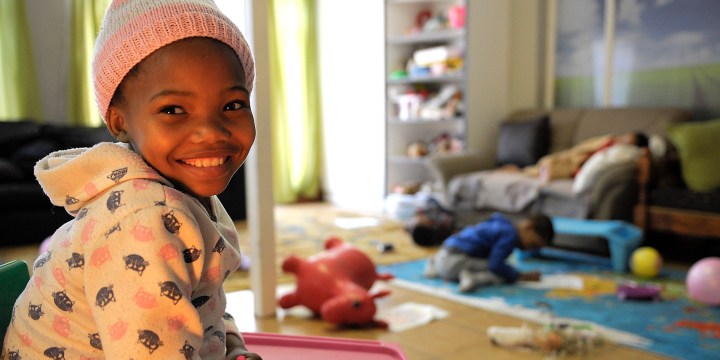SPOTLIGHT
Children’s hospice an oasis for those in need

In July Bloemfontein is dry and hued in shades of brown. Against this backdrop, the Sunflower Children’s Hospice rises like an oasis: The house is covered in bright murals and surrounded by trees and budding shrubs.
Food smells pour from the kitchen of the Sunflower Children’s Hospice in Bloemfontein. There are stuffed toys perched on stools: Barney the dinosaur, a giraffe and a teddy bear.
In 1998, as the Aids epidemic was sweeping through South Africa, paediatric palliative pioneer Joan Marston founded the special hospice for children. At the time, it was a first of its kind in the country. Most of the home’s early patients were babies dying of Aids. Situated next to Bloemfontein’s National District Hospital, its patients have access to top medical and surgical care.
Today, the house is home to 15 young patients with life-threatening diseases. They sleep in 14 donated cots in three bedrooms; the eldest, nine-year-old Fransina, has a bed. At any time two carers are on duty to look after them. Even at night, two members of staff stay awake.
Fransina has spina bifida and kidney problems. In the house’s lounge, she is bent over a small table, meticulously shading a picture with coloured pencils. Next to her is two-and-a-half-year-old Thandeka, recently recovered from kidney removal surgery. Thandeka smiles, chirping greetings and waving at us.
“Thandeka is now absolutely fine,” says the hospice’s manager, Melinda Muller. “But when we got her from Trompsburg she was very sick. We got her and Fransina together — Fransina is from Petrusburg — about a month ago.”
Melinda is sitting behind a large desk, paging through a ledger book where notes on each child are kept. Some children were abandoned by their parents. Some require ARVs or were simply too ill to stay at home. Some were abused — horrific details that cannot be divulged as court cases are underway.
Some of the children, like two-year-old Amo, who is blind with cerebral palsy, will probably never eave the house, as she is too sick. Amo is fed through a tube.
The rest hopefully in time will get well enough to return home or to be released into foster care. Just last year, the hospice released seven children.
“For example, Thandeka won’t go back to her parents,” says Melinda. “But we will see if there is an appropriate relative, otherwise a foster parent to take her in. If so, we will let her new mommy come over here so they can first get used to each other, to see if it works.”
During the interview, there is a small knock on Melinda’s office door. It opens, and Fransina peeks in. “What is it Fransina?” asks Melinda. Fransina enters, pulling a face. “Sister, the salt in the food is burning my tummy. I don’t like my lunch,” she says. Melinda gazes at the young girl patiently. “Now what, dear child?” she asks.
A professional nurse, Melinda has managed the hospice for 10 years. Before that, she worked at the Bloemfontein Mediclinic’s children’s ward.
We see miracles
‘We see miracles,” she says. “Doctors who say there’s nothing more they can do, but then the children get better here. Like this boy, he was in a coma for a year. He had TB meningitis. Then one day he woke up. He went back home, too.”
She says the last time a child died in the house was two years ago. It was a baby with hydrocephalus, a build-up of fluid in the brain. On the house’s outside wall, the deceased girl is remembered: “Bokamoso Kotoyi 12/07/2017 seven months,” reads a small plaque. Around it, many more plaques recall young lives.
“Sickness and death; we explain this to the children in their own terms,” says Melinda. “We tell them that their friend has gone to Jesus.”
Despite all the bright toys and care, do the children miss their own homes? “Yes,” says Melinda. “Most miss home, they do ask for their mothers.”
The hospice’s true scope lies in its outpatient project, which reaches 400 youngsters aged from one-month-old to 18 around Bloemfontein: In the townships of Batho, Joe Slovo, Rocklands and Heidedal, and in surrounding rural towns.
Nurse Olga Molahloe is in charge of the outpatient operation. In the Sunflower bakkie, driven by Thomas Selibe, she visits countless households each day, delivering food parcels — with eggs, long-life milk, pasta, soap, tinned food and tea — ARVs and other medication.
“Sometimes, when the patients are very sick, Thomas becomes an ambulance driver too,” says Olga. “Then he must bring the patient back here to the hospital fast.”
Olga has worked at Sunflower for 26 years. “The relationships you build with the families are very strong,” she says. “And over the course of time the children make you their confidante, it is a big and loving responsibility.”
Making ends meet
The hospice has struggled with finances in the past. But between Joan’s fundraising drives and generous local donations, it makes ends meet.
During Spotlight’s visit, two men with bulging bags arrive at the hospice. They are delivering spinach and pumpkin from a nearby church garden.
“This will be divided between the hospice kitchen and parcels for the outpatients,” says Melinda. Woolworths donates food to the hospice too, as does the Môreson egg farm.
Inside the bedrooms are curtains with cartoon piggies and butterflies, and soft bedding. These were gifts from the local Cheetahs rugby team, which also raised money to have the house painted and its floors newly laminated.
“The rugby players and their wives have done so much, we are very grateful to them,” says Melinda.
Over weekends, Melinda and a friend run a cake and confectionery stand to collect money for the organisation too.
“I know we’re making a real difference. It feels good,” says Melinda, smiling shyly. Behind her, a big sign reads: “Stay focused and never give up.” DM



















 Become an Insider
Become an Insider